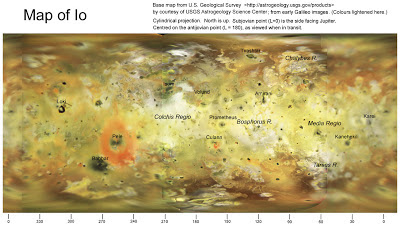One neat thing I've been able to do on this run is take part on observations that are nothing to do with my Saturn proposal. One of those is a proposal from Con Tsang and John Spencer of the Southwest Research Institute in Boulder, CO, to monitor the amount of SO2 in the tenuous atmosphere of Io. Io's volcanoes are belching out this sulphurous material, which falls to the satellites surface and condenses as an SO2 frost. Their TEXES measurements in 2001, 2002 and 2004 showed that the amount of SO2 in the atmosphere varies with Io longitude - there's more over the anti-jovian hemisphere than there is on the side facing Jupiter (Spencer et al., 2005,
doi:10.1016/j.icarus.2005.01.019). There could be two explanations for this - firstly, there's a larger concentration of Io volcanoes on that side of the satellite, so this could be a sensor for that volcanic activity. But it could also just be a measurement of the rate of SO2 frost sublimating into the atmosphere, and there's more frost from those volcanoes on the anti-jovian side. Tsang et al. 2012 (
doi:10.1016/j.icarus.2011.11.005) added in even more TEXES data to fit this same complex of SO2 lines at 530 cm-1 (19 microns), covering 2001-2010, and found that the amount of SO2 varied with time, being more abundant when Jupiter was closer to the sun (perihelion), supporting the idea that Io's atmosphere is at least partially supported by frost sublimation.
The point of these Io observations over the next few nights is to get a new map of Io's SO2 distribution, and to see if the atmosphere has shown signs of deflation after perihelion (March 2011, when presumably SO2 evaporation was at the highest rate). Io goes around Jupiter once every 1.8 days, meaning that a sequence of consecutive nights will allow us to map most of the longitudes to see if the contrasts have changed with time. The hope is that this will differentiate between atmospheric support from volcanic injection, or from frost sublimation.... but the suspicion from Tsang et al. is that there must be at least a little volcanic injection, given that they saw SO2 in the atmosphere still during the aphelion. Con and John were both following along remotely, so I'm sure they'll have their work cut out in analysing this new TEXES Io dataset!

No comments:
Post a Comment